|
|
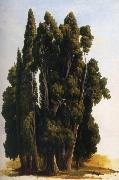 |
Gustaf Wilhelm Palm
|
|
Swedish, 1810-1890,Swedish painter. He entered the Royal Academy of Arts in Stockholm in 1828, where he was a student of Carl Johan Fahlcrantz. Following a tour of Norway he went, via Copenhagen, to Berlin and Vienna for three years in order to seek a cure for an eye illness. He was influenced there by Biedermeier painting and Ferdinand Georg Waldm?ller, and also by the architectural painters Jakob Alt (1789-1872) and his son Rudolf Alt. |
|
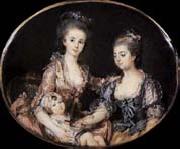 |
HALL, Peter Adolf
|
|
1739-1793
Swedish painter and collector. In 1753 he attended Uppsala Universitet to study medicine and natural history. In 1755 he went on a study trip abroad, led by his drawing-master Lars Brisman. While in Germany (1756-9) he studied miniature painting with Eichhardt in Berlin and with Karl Friedrich Wilhelm Richard (1725-70) in Hamburg. After this trip, he decided to become a professional portrait painter, and in 1759 he enrolled at the Kungliga Akademi for de Fria Konsterna in Stockholm, studying drawing with the French sculptor Pierre-Hubert Larchaveque (1721-78) and painting with Gustaf Lundberg. He attracted the attention of C. F. Adelcrantz, who in 1766 gained for him a commission for the pastel portrait of Princes Karl and Fredrik Adolf. In that year he also executed a miniature portrait of Crown Prince Gustav on the occasion of his engagement to Princess Sophia Magdalena of Denmark. Also in 1766 he received a royal travel grant to study in Paris, where he developed a completely new technique of miniature painting using sweeping brushwork and a clear and fresh range of colour that allowed for lively characterization. He made exquisite detailed studies of the backgrounds of his paintings, as well as his sitters costumes and their attributes and accessories. His new technique involved applying gouache to the ivory in a manner that allowed the ivory to show through, a method that was particularly successful in depicting drapery. The smooth surface of the ivory also allowed freer brushwork associated with full-scale portraits. |
|
|
|
|
|
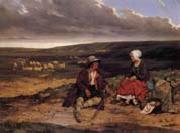 |
Hedouin Pierre
|
|
A fine French painter, etcher and lithographic artist , Boulogne 1820-Paris 1889
|
|
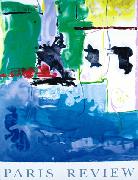 |
Helen Frankenthaler Prints
|
|
Born 1928
Helen Frankenthaler (born December 12, 1928) is an American post-painterly abstraction artist. Born in New York City, she was influenced by Jackson Pollock's paintings and by Clement Greenberg. She was the youngest daughter of a justice on the New York State Supreme Court. She studied at the Dalton School under Rufino Tamayo and also at Bennington College in Vermont. She later married fellow artist Robert Motherwell. |
|
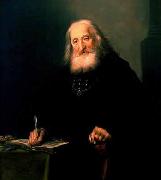 |
Hendrik Gerritsz. Pot
|
|
(c. 1580 - 15 October 1657 (buried)) was a Dutch painter. He lived and painted in Haarlem, where he was an officer of the militia, or schutterij. Dutch artist Frans Hals painted Pot in militia sash in Hals' The Banquet of the Officers of the St George Militia Company (c. 1639). Pot is the man reading a book on the far right.
Pot was born in Amsterdam and spent his early years in Amsterdam and Haarlem. In 1632 he traveled to London, where he painted the Royal Family. He lived from 1633 to 1648 in Haarlem, after which he moved to Amsterdam, where he died in 1657.. He served as Dean of the Haarlem Guild of St. Luke in 1626, 1630 and 1635. He served as the Guild's headman or Hoofdman in 1634 and 1648. He died in Amsterdam. |
|
 |
Henri Felix Emmanuel Philippoteaux
|
|
(1815-1884) was a French artist. He was born in Paris, France, studied art at the studio of Leon Cogniet,and first exhibited his work at the Paris Salon of 1833.
One of his most well-known works was a depiction of the Siege of Paris during the Franco-Prussian War, painted in the form of a cyclorama, a type of large panoramic painting on the inside of a cylindrical platform designed to provide a viewer standing in the middle of the cylinder with a view of the painting. Viewers surrounded by the panoramic image are meant to feel as if they are standing in the midst of a historic event or famous place.
Philippoteaux also produced a large number of works chronicling the rise and successes of Napoleon Bonaparte, including a portrait of Napoleon in his regimental uniform and a group of paintings of French victories in the Napoleonic Wars. Philippoteaux was awarded the Legion d'honneur in 1846.
Philippoteaux's son Paul Philippoteaux was also an artist; both were famous for their production of cycloramas. Father and son collaborated on The Defence of the Fort d'Issy in 1871. |
|
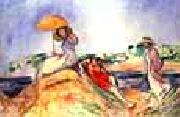 |
Henri Lebasque Prints
|
|
French Painter, 1865-1937
was born in 1865 at Champign?? (Maine-et-Loire). He started his education at the Ecole des Beaux-Arts d??Angers, and moved to Paris in 1886. Here, Lebasque started studying under L??on Bonnat, and assisted Humbert with the decorative murals at the Panth??on. Around this time, Lebasque met Camille Pissarro and Auguste Renoir, who later would have a large impact on his work.
Lebasque's vision was coloured by his contact with younger painters, especially Edouard Vuillard and Pierre Bonnard, founders of the The Nabis' Group and the Intimists who first favoured the calm and quietude of domestic subject matter. From his first acquaintance with Georges Seurat and Paul Signac, Lebasque learnt the significance of a colour theory which stressed the use of complementary colours in shading.
Lebasque was a founding member of the Salon d'Automne in 1903 with his friend Henri Matisse. Two years later a group of artists exhibited there including Georges Rouault, Andr?? Derain, Edouard Vuillard and Henri Matisse while keeping solid links with other artists such as Gustave Rouault, Raoul Dufy, Louis Valtat and especially Henri Manguin, who made him discover the south of France.
His time in South of France would lead to a radical transformation in Lebasque??s paintings, changing his colour palette forever. Other travels included the Vend??e, Normandie and Brittany, although Lebasque would always prefer the small idyllic villages of the South of France.
Lebasque had some commercial success during his lifetime. He worked on the decorations at the theatre of the Champs-Elys??es and of the Transatlantique sealiner.
Lebasque died at Cannet, Alpes Maritimes in 1937.
His work is represented in French museums, notably Angers, Geneva (Petit Palais), Lille (Mus??e des Beaux-Arts), Nantes and Paris (Mus??e d??Orsay) as well as many more around the world. Famed as a painter of 'joy and light', Lebasque is admired for the intimacy of his subject matter and his unique delight in colour and form. |
|
 |
Henri Martin Prints
|
|
French Post-Impressionist Painter, 1860-1943
Born in Toulouse to a French cabinet maker and a mother of Italian descent, Martin successfully persuaded his father to permit him to become an artist. He began his career in 1877 at the Toulouse School of the Fine Arts, where he was under the tutelage of Jules Garipuy (he was also a pupil of Eug??ne Delacroix). In 1879, Martin relocated to Paris and with the help of a scholarship, was able to study in Jean-Paul Laurens' studio. Four years later, he received his first medal at the Paris Salon, where he would hold his first exhibition three years later in 1886.
The year after he won his first medal, Martin was awarded a scholarship for a tour in Italy, where he studied the work of veterans such as Giotto and Masaccio. His 1889 canvas submission to the Salon earned him the gold medal for work that has been described as Pointillist. That same year he became a member of the Legion of Honour. At the 1900 World Fair, he was awarded the Grand Prize for his work. During this period, he became friends with Auguste Rodin.
Although Martin's work as a neo-impressionist is not considered groundbreaking, his work was rather well-received, and has been associated with world-class symbolist painter, Puvis de Chavannes.
Due to his introverted temperament, Martin decided to move away from Paris. After a decade of searching for an ideal home, Martin bought Marquayrol, a mansion overlooking La Bastide du Vert, near Cahors. He performed his best work in the new tranquil environment, and died there in 1943. |
|
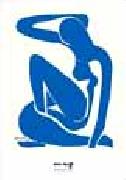 |
Henri Matisse Prints
|
|
French Fauvist Painter and Sculptor, 1869-1954
Henri Matisse (31 December 1869 ?C 3 November 1954) was a French artist, known for his use of colour and his fluid, brilliant and original draughtsmanship. As a draughtsman, printmaker, and sculptor, but principally as a painter, Matisse is one of the best-known artists of the 20th century. Although he was initially labeled as a Fauve (wild beast), by the 1920s, he was increasingly hailed as an upholder of the classical tradition in French painting. His mastery of the expressive language of colour and drawing, displayed in a body of work spanning over a half-century, won him recognition as a leading figure in modern art.
Around 1904 he met Pablo Picasso, who was 12 years younger than him. The two became life-long friends as well as rivals and are often compared; one key difference between them is that Matisse drew and painted from nature, while Picasso was much more inclined to work from imagination. The subjects painted most frequently by both artists were women and still lifes, with Matisse more likely to place his figures in fully realized interiors. Matisse and Picasso were first brought together at the Paris salon of Gertrude Stein and her companion Alice B. Toklas. During the first decade of the 20th century, Americans in Paris Gertrude Stein, her brothers Leo Stein, Michael Stein and Michael's wife Sarah were important collectors and supporters of Matisse's paintings. In addition Gertrude Stein's two American friends from Baltimore Clarabel and Etta Cone became major patrons of Matisse and Picasso, collecting hundreds of their paintings. The Cone collection is now exhibited in the Baltimore Museum of Art.
His friends organized and financed the Acad??mie Matisse in Paris, a private and non-commercial school in which Matisse instructed young artists. It operated from 1911 until 1917. Hans Purrmann and Sarah Stein were amongst several of his most loyal students. |
|
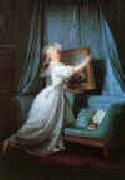 |
Henri Pierre Danloux
|
|
1753-1809 French
French painter and draughtsman. He was orphaned at an early age and was brought up by an uncle who was an architect and contractor. Around 1770 his uncle apprenticed him to Nicolas-Bernard Lpici. He exhibited for the first time in 1771 at the Exposition de la Jeunesse in Paris, where he showed a Drunkard at a Table (untraced). About 1773 he was admitted into the studio of Joseph-Marie Vien, whom he followed to Rome in 1775 on the latter appointment as Director of the Academie de France. Danloux sketchbooks show that he also travelled to Naples, Palermo, Florence and Venice. He was not interested in the monuments of antiquity but concentrated instead on drawing landscapes and, in particular, portraits, among them that of Jacques-Louis David. |
|
 |
Henri-Horace Roland de La Porte
|
|
Paris 1724-1793
French painter. He was a pupil of Jean-Baptiste Oudry and was approved by the Academie Royale de Peinture et de Sculpture in 1761 as a 'painter of animals and fruit'. He presented his morceau de reception, the ambitious Vase of Lapis, Ornamented with Bronze and Placed near a Globe (Paris, Louvre), in 1763. This large painting is reminiscent of Oudry's work and depicts a collection of sumptuous objects against a simple cloth backdrop. Roland de la Porte's later works are much more intimate in scale and approach and depict simple rustic objects in a restrained yet realistic fashion in a manner akin to Chardin, for whose works his own have been mistaken. The Still-life with Bread and Fruit (Rotterdam, Boymans-van Beuningen) is bathed in a warm light; the composition is unusual in that the bread, plums and preserve pot are represented at the viewer's eye level, obscuring the top of the table. The Little Orange Tree (Karlsruhe, Staatl. Ksthalle) uses several devices similar to those used by Chardin: a light source comes from the upper left-hand side, throwing some of the surfaces into relief and highlighting them against the indistinct background; a single straw is brought into focus and seems to protrude out of the picture |
|
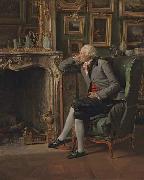 |
Henri-Pierre Danloux
|
|
(February 24, 1753 - January 3, 1809) was a French painter and draftsman.
He was born in Paris. Brought up by his architect uncle, Danloux was a pupil of Lepicie and later of Vien, whom he followed to Rome in 1775. In 1783, he returned to Lyon and Paris, where he was patroned by the Baronne Megret de Serilly d'Etigny, who secured for him a number of important portrait commissions. He emigrated to London in 1792 during the French Revolution and returned to Paris in 1801. Danloux was influenced by fashionable English portrait painters such as Thomas Lawrence (1769-1830), John Hoppner (1758-1810), and George Romney (1734-1802). In 1793, he exhibited at the Royal Academy in London which resulted in commissions from a number of British patrons. Danloux returned to Paris in 1801, and died there in 1809. |
|
 |
Henri-Pierre Picou
|
|
(27 February 1824 - 17 July 1895) was a French painter born in Nantes.His oeuvre began with portraits and classical historical subject matter but he later moved on to allegorical and mythological themes.He was an academic painter and one of the founders of the Neo-Grec school, along with his close friends Gustave Boulanger, Jean-L??on G??rôme, and Jean-Louis Hamon, also academic painters. All of them studied in the workshops of both Paul Delaroche and later Charles Gleyre. Picou's style was noticeably influenced by Gleyre. While the rest of the group generally painted classical and mythological subjects, Picou also received commissions for large religious frescoes from many churches, including the Église Saint-Roch.
His artistic debut was at the Salon in 1847. The next year he was awarded a second-class medal for his painting, Cl??opâtre et Antoine sur le Cydnus. Also known as Cleopatra on the Cydnus, it is commonly regarded as Picou's masterpiece. This showing at the Salon in 1848 was written about by the critic Th??ophile Gautier, who felt that the subject matter was too ambitious, but also said that "As it is, it gives the best hope for the future of the young artist, and ranks among the seven or eight most important paintings of the Salon.In 1875 the painting was exhibited in New York, and afterward found lodgment on the walls of a private art gallery in San Francisco.Picou maintained a large workshop in Paris on the Boulevard de Magenta, which provided him room to work on his expansive frescoes. His popularity continued to rise and he went on to win the Second Prix de Rome in 1853 for his painting, J??sus chassant les vendeurs du Temple (The Moneylenders Chased from the Temple), and another second-class medal for his Salon painting in 1857. From his debut in 1847, he was a regular at the Salon, showing almost every year until his final exhibit in 1893.He has been called the most fashionable painter towards the close of the Second French Empire |
|
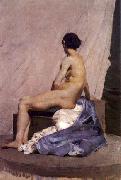 |
Henrique Pousao
|
|
Henrique Cear de Arauo Pousa (Vila Vicsa, 1 January 1859 - Vila Vicsa, 20 March 1884) was a Portuguese painter.
|
|
|
|
|
|
|
|
|
|
|
|
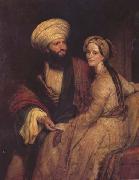 |
Henry William Pickersgill
|
|
English Painter, 1782-1875
was an English painter specialising in portraits. He was a Royal Academician for almost fifty years, and painted many of the most notable figures of his time. Born in London, Pickersgill was adopted in his youth by a Mr Hall, a silk manufacturer in Spitalfields, who financed his schooling and then took him into the family business. However, when war caused difficult trading conditions, Pickersgill opted to develop his talent for painting into a career, and was a pupil of landscape artist George Arnald between 1802 - 1805 before entering the Royal Academy Schools as a student in November 1805.His early subjects were varied and included landscapes and classical and historical themes, but he eventually settled to portraiture as his speciality. His first exhibit at the Royal Academy was a portrait of his benefactor Mr Hall, and during his lifetime he showed a total of 384 paintings there. He was elected to associate membership of the Academy in November 1822 and full membership in February 1826. Pickersgill was one of the pre-eminent portrait painters of his day. William Wordsworth, George Stephenson, Jeremy Bentham, Elizabeth Barrett Browning, Lord Nelson, the Duke of Wellington and Faraday were among the many notable people who sat for him. He famously painted author James Silk Buckingham and his wife Elizabeth in Arab costume in 1816, reflecting Buckingham's own travels in the East as well as the fashion of the times for the Orient. The National Portrait Gallery, London has over 50 of his portraits in its collection, including 16 original oils and 35 engravings after him, along with a small number of portraits of Pickersgill himself by others. From 1856?C64 he was librarian of the Royal Academy. He retired from the institution in December 1872, and died at his home in Blandford Square, London at the age of 93. Pickersgill's brother Richard, son Henry Hall and nephew Frederick Richard were also painters. |
|
|
|
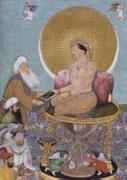 |
Hindu painter
|
|
Richard Ettinghausen believes this work to have been painted in Agra in about 1625
|
|
|
|
 |
Hiram Powers
|
|
American Neoclassical Sculptor, 1805-1873, American sculptor. He grew up in Cincinnati, OH, and his career as a sculptor began when he created animated wax figures for a tableau of Dante's Inferno at Dorfeuille's Western Museum in Cincinnati, where he was supervisor of the mechanical department. He learnt to model clay and make plaster casts from Frederick Eckstein (c. 1775-1852). The portrait busts he created of his friends attracted the attention of the wealthy Nicholas Longworth, who financed trips for Powers to New York in 1829 and to Washington, DC, in 1834, when he sculpted President Andrew Jackson (marble, c. 1835; New York, Met.). Powers's strikingly lifelike bust, classicized only by the drapery, brought him commissions from other Washington luminaries, including John Marshall (marble, 1835; Washington, DC, US Capitol), Martin van Buren (marble, 1837; New York, NY Hist. Soc.) |
|
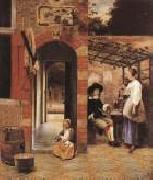 |
HOOCH, Pieter de
|
|
Dutch Baroque Era Painter, 1629-1684
Dutch painter. He was one of the most accomplished 17th-century Dutch genre painters, excelling in the depiction of highly ordered interiors with domestic themes and merry companies and pioneering the depiction of genre scenes set in a sunlit courtyard. The hallmarks of his art are an unequalled responsiveness to subtle effects of daylight, and views to adjoining spaces, either through a doorway or a window, |
|
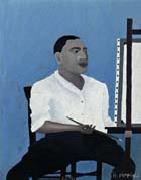 |
Horace pippin
|
|
1888-1946
was a self-taught African-American painter who worked in a naive style. The injustice of slavery and American segregation figure prominently in many of his works. He was born in West Chester, Pennsylvania, and grew up in Goshen, New York. There he attended segregated schools until he was 15, when he went to work to support his ailing mother.Pippin served in the 369th infantry in Europe during World War I, where he lost the use of his right arm. He said of his combat experience: His activity as a painter did not begin in earnest until 1930. One of his best-known paintings, his Self-portrait of 1941, shows him seated in front of an easel, cradling his brush in his right hand (he used his left arm to guide his injured right arm when painting). His painting of John Brown Going to his Hanging (1942) is in the collection of the Pennsylvania Academy of the Fine Arts in Philadelphia. Among Pippin's works are many genre paintings, such as the Domino Players (1943), in the Phillips Collection, Washington D.C., and several versions of Cabin in the Cotton. |
|
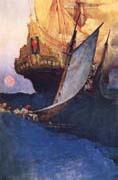 |
Howard Pyle
|
|
One of the great illustrators of the 19th century.
American
1853-1911
was an American illustrator and writer, primarily of books for young audiences. A native of Wilmington, Delaware, he spent the last year of his life in Florence, Italy. In 1894 he began teaching illustration at the Drexel Institute of Art, Science and Industry (now Drexel University), and after 1900 he founded his own school of art and illustration called the Howard Pyle School of Illustration Art. The term the Brandywine School was later applied to the illustration artists and Wyeth family artists of the Brandywine region by Pitz (later called the Brandywine School). Some of his more famous students were Olive Rush, N. C. Wyeth, Frank Schoonover, Elenore Abbott, and Jessie Willcox Smith. His 1883 classic The Merry Adventures of Robin Hood remains in print to this day, and his other books, frequently with medieval European settings, include a four-volume set on King Arthur that cemented his reputation. He wrote an original work, Otto of the Silver Hand, in 1888. He also illustrated historical and adventure stories for periodicals such as Harper's Weekly and St. Nicholas Magazine. |
|
|
|
 |
Ignacio Pinazo
|
|
1849-1916
He came from a poor family and in his youth worked as a silversmith, gilder, tile painter and hatter. This experience encouraged an independent spirit unencumbered by academic doctrine. He did, however, attend the Escuela de Bellas Artes in Valencia while working as a hatter, studying colour and composition, life drawing and drawing from the Antique (1868-9). In 1870 he started to devote himself wholly to painting. His early works include several portraits. A series of stays in Italy were important for Pinazo's development. The first of these took place in 1873, when he spent seven months visiting Rome, Naples and Venice and became familiar with the work of Mariano Jos? Bernardo Fortuny y Marsal, whose influence can be seen in Pinazo's small-scale landscapes on panel . Soon, however, his work came to resemble that of the impressionistic Italian painters, the Macchiaioli, as in Pinazo's brightly coloured Wheat-field. His second stay in Italy began in 1877 with an award for his large history painting, Landing of Francis I of France in Valencia |
|
 |
Ignacio Pinazo Camarlench
|
|
Spanish painter , 1849-1916
was a Spanish painter, and one of the most prominent artists of Valencia from the end of the nineteenth century, working in the Impressionist style. Born into a poor family, Pinazo was forced from a young age to assist in supporting the family by practising various trades. He had only attended eight grades when his mother died of the cholera, and young Ignazio was variously employed as a silversmith, a painter of tiles, and a decorator of fans. After his father's death, he lived with his grandparents, and in 1864 enrolled in the San Carlos Academy of Fine Arts, Valencia, earning his living as a hatter. His artistic career started when he was 21, and he achieved his first success in Barcelona three years later. In 1871, work by him was displayed in the National Exhibition of Fine Arts for the first time. He visited Rome twice, the first time (1873) thanks to the sale of a painting. From 1876 to 1881 he lived in that city on a grant. When he returned to his native city in 1874, he abandoned the conventional historic themes he had so far devoted his efforts to, and instead started painting family subjects, nude figures, and scenes from daily life, thereby anticipating Joaqu'n Sorolla y Bastida and Francisco Domingo both in subject and style. |
|
|
|
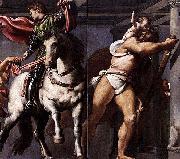 |
Il Pordenone
|
|
(c. 1484 - 1539), was an Italian painter of the Venetian school, active during the Renaissance. Vasari, his main biographer, identifies him as Giovanni Antonio Licinio.
He was commonly named il Pordenone from having been born in 1483 at Corticelli, a small village near Pordenone in Friuli. He ultimately dropped the name of Licinio, having quarrelled with his brothers, one of whom had wounded him in the hand; he then called himself Regillo, or De Regillo. Others say he once took up his maternal name of Cuticelli[1] His signature runs Antonius Portunaensis, or De Portunaonis. He was knighted as a cavaliere by Charles V.
As a painter, Pordenone was a scholar of Pellegrino da San Daniele, but a leading influence of his style was Giorgione; the popular story that he was a fellow-pupil with Titian under Giovanni Bellini is false. It was claimed that Pordenone's first commission was given him by a grocer in his home town, to try his boast that he could paint a picture as the priest commenced High Mass, and complete it by the time Mass was over; he completed the picture in the required time.[2] The district about Pordenone had been somewhat fertile in capable painters; but Pordenone is the best known, a vigorous chiaroscurist and flesh painter. The 1911 Britannica states that "so far as mere flesh-painting is concerned he was barely inferior to Titian in breadth, pulpiness and tone". The two were rivals for a time, and Licinio would sometimes affect to wear arms while he was painting. He excelled in portraits; he was equally at home in fresco and in oil-color. He executed many works in Pordenone and elsewhere in Friuli, Cremona, and Venice; at one time he settled in Piacenza, where one of his most celebrated church pictures, St. Catherine disputing with the Doctors in Alexandria is located; the figure of St. Paul in connection with this picture is his own portrait.
|
|
|
|
|
|
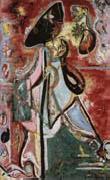 |
Jackson Pollock
|
|
l912--1956,U.S. painter. He grew up in California and Arizona. In the early 1930s he studied in New York City under Thomas Hart Benton, and later he was employed on the WPA Federal Art Project. In 1945 he married the artist Lee Krasner. Two years later, after several years of semiabstract work stimulated by psychotherapy, Pollock began to lay his canvas on the floor and pour or drip paint onto it in stages. This process permitted him to record the force and scope of his gestures in trajectories of enamel or aluminum paint that veiled the figurative elements found in his earlier work. The results were huge areas covered with complex and dynamic linear patterns that fuse image and form and engulf the vision of the spectator in their scale and intricacy. Pollock believed that art derived from the unconscious and judged his work and that of others on its inherent authenticity of personal expression. He became known as a leading practitioner of Abstract Expressionism, particularly the form known as action painting. Championed by critic Clement Greenberg and others, he became a celebrity. When he died in a car crash at 44, he was one of the few American painters to be recognized during his lifetime and afterward as the peer of 20th-century European masters of modern art. |
|
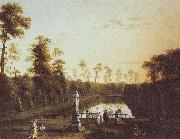 |
Jacob Philipp Hackert
|
|
(September 15, 1737 - April 28, 1807) was a landscape painter from Brandenburg, who did most of his work in Italy.
Hackert was born in 1737 in Prenzlau in the Margraviate of Brandenburg (now in Germany). He trained with his father Philipp (a portraitist and painter of animals) and his uncle, before going to the Akademie der Kenste in Berlin in 1758. Later he traveled to Swedish Pomerania and Stockholm, where he painted murals.
He spent from 1765 to 1768 in Paris, with the Swiss Artist, Balthasar Anton Dunker, where he focused on painting in gouache. He met and was inspired by Claude Joseph Vernet, who was already famous as a painter of landscapes and seascapes, and the German engraver Johann Georg Wille.
In 1768 Hackert left Paris with his brother Georg, and went to Italy, basing himself mainly in Rome and Naples, where he produced many works for Sir William Hamilton. He travelled all over Italy, gaining a reputation as a talented landscape painter.
In 1786 he went to work for Ferdinand I of the Two Sicilies in Naples. He advised on the creation of a painting restoration laboratory at the Museo di Capodimonte, and supervised the transfer of the Farnese collections from Rome to Naples. By this time he had an international reputation, and won commissions from empress Catherine II of Russia, king Louis XVI of France and others. When Goethe visited Naples in 1786, he and Hackert became friends. |
|
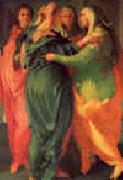 |
Jacopo Pontormo
|
|
Italian 1494-1557 Jacopo Pontormo Galleries
Italian painter and draughtsman. He was the leading painter in mid-16th-century Florence and one of the most original and extraordinary of Mannerist artists. His eccentric personality, solitary and slow working habits and capricious attitude towards his patrons are described by Vasari; his own diary, which covers the years 1554-6, further reveals a character with neurotic and secretive aspects. Pontormo enjoyed the protection of the Medici family throughout his career but, unlike Agnolo Bronzino and Giorgio Vasari, did not become court painter. His subjective portrait style did not lend itself to the state portrait. He produced few mythological works and after 1540 devoted himself almost exclusively to religious subjects. His drawings, mainly figure studies in red and black chalk, are among the highest expressions of the great Florentine tradition of draughtsmanship; close to 400 survive, forming arguably the most important body of drawings by a Mannerist painter. His highly personal style was much influenced by Michelangelo, though he also drew on northern art, primarily the prints of Albrecht Derer. |
|
|
|
 |
James Baker Pyne
|
|
English Painter, 1800-1870
He was articled to a Bristol attorney, but around 1821 he took up painting and exhibited at the Bristol Gallery of Arts in 1824. Apparently self-taught, he worked closely with the Bristol artist Samuel Jackson (1794-1869) for a time and was influenced by the poetic landscapes of Francis Danby. In 1835 he moved to London and exhibited at the Royal Academy the following year. He showed seven pictures there altogether, but he also exhibited at the British Institution and showed 206 works at the Society of British Artists. Although technically accomplished, Pyne's work is curiously lacking in distinction. He imitated many artists but never found a style of his own. His early views of Bristol are among his best work, a good example being View of the Avon from Durdham Down (1829; Bristol, Mus. & A.G.). He also painted some lively coast scenes such as Whitby (Leicester, Mus. & A.G.). He was less successful when emulating J. M. W. Turner. |
|
|
|
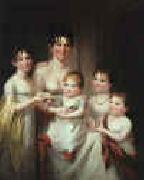 |
James Peale
|
|
1749-1831
James Peale Galleries
James Peale (1749 ?C May 24, 1831) was an American painter, best known for his miniature and still life paintings, and a younger brother of noted painter Charles Willson Peale.
Peale was born in Chestertown, Maryland, the second child, after Charles, of Charles Peale (1709?C1750) and Margaret Triggs (1709?C1791). His father died when he was an infant, and the family moved to Annapolis. In 1762 he began to serve apprenticeships there, first in a saddlery and later in a cabinetmaking shop. After his brother Charles returned from London in 1769, where he had studied with Benjamin West, Peale served as his assistant and learned how to paint.
Peale worked in his brother's studio until January 14, 1776, when he accepted a commission in the Continental Army as an ensign in William Smallwood's regiment. Within three months he was promoted to captain, and during the next three years fought in the battles of Long Island, White Plains, Trenton, Brandywine, Germantown, Princeton, and Monmouth. He resigned his army commission in 1779, and moved to Philadelphia to live with his brother. In 1782 he married, after which he established his own household and artistic career. (One notable later collaboration, however, was in 1788 to make floats for Philadelphia's Federal Procession in honor of the newly drafted United States Constitution.)
At the outset of his career Peale painted portraits and still-life, and by the mid-1780s had established his reputation. At about this time, however, Charles turned over his own miniature portrait practice to him, and throughout the 1790s and early 1800s Peale devoted himself to miniature painting. Much of this work was watercolor on ivory. In 1795 Peale exhibited a still life of fruit along with nine miniatures and his family portrait at the Columbianum, a short-lived art academy in Philadelphia. Around 1810, as Peale's eyesight began to weaken, he gave up painting miniatures to turn to large portraits and still-life subjects that were greatly admired and widely exhibited in Philadelphia, Boston, and Baltimore.
The total number of Peale's landscape paintings remains unknown, but he executed more than 200 watercolor miniatures on ivory, perhaps 100 still-life paintings, fewer than 70 oil portraits, and at least 8 history paintings.
Peale died in Philadelphia on May 24, 1831. Three of his six children became accomplished painters: Anna Claypoole Peale (1798?C1871), a miniaturist and still-life painter; Margaretta Angelica Peale (1795?C1882), painter of trompe l??oeil subjects and tabletop fruit; and Sarah Miriam Peale (1800?C1885), a portraitist and still-life painter. |
|
 |
James Peele
|
|
James Peale (1749 - May 24, 1831) was an American painter, best known for his miniature and still life paintings, and a younger brother of noted painter Charles Willson Peale.
Peale was born in Chestertown, Maryland, the second child, after Charles, of Charles Peale (1709 - 1750) and Margaret Triggs (1709 - 1791). His father died when he was an infant, and the family moved to Annapolis. In 1762 he began to serve apprenticeships there, first in a saddlery and later in a cabinetmaking shop. After his brother Charles returned from London in 1769, where he had studied with Benjamin West, Peale served as his assistant and learned how to paint.
Peale worked in his brother's studio until January 14, 1776, when he accepted a commission in the Continental Army as an ensign in William Smallwood's regiment. Within three months he was promoted to captain, and during the next three years fought in the battles of Long Island, White Plains, Trenton, Brandywine, Germantown, Princeton, and Monmouth. He resigned his army commission in 1779, and moved to Philadelphia to live with his brother. In 1782 he married, after which he established his own household and artistic career. (One notable later collaboration, however, was in 1788 to make floats for Philadelphia's Federal Procession in honor of the newly drafted United States Constitution.) |
|
|
|
 |
Jan Bogumil Plersch
|
|
painted Tadeusz Kosciuszko falling wounded in the battle of Maciejowice in 1794 |
|
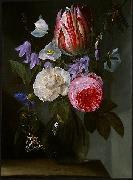 |
Jan Philip van Thielen
|
|
(Mechelen, 1618 - Mechelin, 1667) was a Flemish Baroque painter who specialized in flowers.
Van Thielen was the son of a minor nobleman and eventually assumed the title of Lord of Couwenberch. In 1631 or 1632 he began studying at the age of thirteen with his future brother-in-law, the history painter Theodoor Rombouts (1597-1637), and in 1641 he commenced his studies with the flower painter Daniel Seghers (1590-1661). According to Houbraken (who mistakenly wrote his birth year as 1681 instead of 1618), his reputation during his lifetime was such that he received patronage from the Spanish crown, |
|
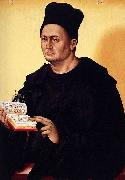 |
Jan Polack
|
|
Jan Polack Johannes Po(l)lack (Hanns Polagk, Polegk), (Latin: Ioannes Polonus) (between 1435 and 1450 (possibly in Krakew) - 1519 in Munich) was a 15th-century painter.
From his nickname it is assumed that he might have worked in Krakew. From the mid-1470s on, he lived and worked in Munich, having previously been in Franconia. He may have taken part in the 1475 festival of the Landshut Wedding of Jadwiga Jagiellon and George of Bavaria. In 1480 he opened his own shop in Munich.
Starting in 1482 he is listed on the tax records of Munich, also as leader of the local painter guild. He visited with Michael Wohlgemuth and his art was influenced by him and by that of Veit Stoss and Hans Pleydenwurff as well as by collaboration with the woodcutter Erasmus Grasser.
Documents mention many works of his which are now lost. His most important remaining work is the Weihenstephan altarpiece (1483 - 1485), now at the Alte Pinakothek in Munich.
|
|
 |
Jan Porcellis
|
|
(1583/5 - 29 January 1632) was a Dutch marine artist.
Porcellis was born in Ghent. He was the father of the marine artist Julius Porcellis (they shared a similar repertoire of subjects and an identical signature monogram), and is generally agreed to be the more fluent artist, particularly in his sense of space and his tonal palette (subtler than his son's). He died at Zoeterwoude.
|
|
|
|
|

